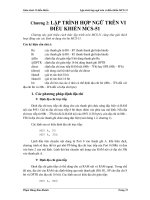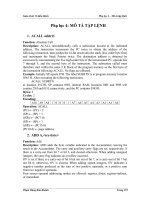GIÁO TRÌNH VI ĐIỀU KHIỂN part 10 ppsx
Bạn đang xem bản rút gọn của tài liệu. Xem và tải ngay bản đầy đủ của tài liệu tại đây (239.01 KB, 14 trang )
Sưu tầm bởi:
www.daihoc.com.vn
Giáo trình Vi điều khiển Phụ lục 4 – Mô tả tập lệnh
Phạm Hùng Kim Khánh Trang 221
Cycles: 2
Encoding:
1110001i
Operation: MOVX
(A) ← ((Ri))
32.2. MOVX A,@DPTR
Bytes: 1
Cycles: 2
Encoding:
11100000
Operation: MOVX
(A) ← ((DPTR))
32.3. MOVX @Ri,A
Bytes: 1
Cycles: 2
Encoding:
1111001i
Operation: MOVX
((Ri)) ← (A)
32.4. MOVX @DPTR,A
Bytes: 1
Cycles: 2
Encoding:
11110000
Operation: MOVX
(DPTR) ← (A)
33. MUL AB
Function: Multiply
Description: MUL AB multiplies the unsigned 8-bit integers in the Accumulator and
register B. The low-order byte of the 16-bit product is left in the Accumulator, and the
high-order byte in B. If the product is greater than 255 (0FFH), the overflow flag is
set; otherwise it is cleared. The carry flag is always cleared.
Example: Originally the Accumulator holds the value 80 (50H). Register B holds the
value 160 (0A0H). The instruction,
MUL AB
will give the product 12,800 (3200H), so B is changed to 32H (00110010B) and the
Accumulator is cleared. The overflow flag is set, carry is cleared.
Bytes: 1
Cycles: 4
Sưu tầm bởi:
www.daihoc.com.vn
Giáo trình Vi điều khiển Phụ lục 4 – Mô tả tập lệnh
Phạm Hùng Kim Khánh Trang 222
Encoding:
10100100
Operation: MUL
(A)
7-0
← (A) X (B)
(B)
15-8
34. NOP
Function: No Operation
Description: Execution continues at the following instruction. Other than the PC, no
registers or flags are affected.
Example: A low-going output pulse on bit 7 of Port 2 must last exactly 5 cycles. A
simple SETB/CLR sequence generates a one-cycle pulse, so four additional cycles
must be inserted. This may be done (assuming no interrupts are enabled) with the
following instruction sequence,
CLR P2.7
NOP
NOP
NOP
NOP
SETB P2.7
Bytes: 1
Cycles: 1
Encoding:
00000000
Operation: NOP
(PC) ← (PC) + 1
35. ORL<dest-byte>,<src-byte>
Function: Logical-OR for byte variables
Description: ORL performs the bitwise logical-OR operation between the indicated
variables, storing the results in the destination byte. No flags are affected.
The two operands allow six addressing mode combinations. When the destination is
the Accumulator, the source can use register, direct, register-indirect, or immediate
addressing; when the destination is a direct address, the source can be the
Accumulator or immediate data.
Note: When this instruction is used to modify an output port, the value used as the
original port data is read from the output data latch, not the input pins.
Example: If the Accumulator holds 0C3H (11000011B) and R0 holds 55H
(01010101B) then the following instruction,
ORL A,R0
leaves the Accumulator holding the value 0D7H (1101011lB).When the destination is
a directly addressed byte, the instruction can set combinations of bits in any RAM
location or hardware register. The pattern of bits to be set is determined by a mask
byte, which may be either a constant data value in the instruction or a variable
Sưu tầm bởi:
www.daihoc.com.vn
Giáo trình Vi điều khiển Phụ lục 4 – Mô tả tập lệnh
Phạm Hùng Kim Khánh Trang 223
computed in the Accumulator at run-time. The instruction,
ORL P1,#00110010B
sets bits 5, 4, and 1 of output Port 1.
35.1. ORL A,Rn
Bytes: 1
Cycles: 1
Encoding:
01001
r
r
r
Operation: ORL
(A) ← (A) ∨ (Rn)
35.2. ORL A,direct
Bytes: 2
Cycles: 1
Encoding:
0 1 000101direct address
Operation: ORL
(A) ← (A) ∨ (direct)
35.3. ORL A,@Ri
Bytes: 1
Cycles: 1
Encoding:
0100011i
Operation: ORL
(A) ← (A) ∨ ((Ri))
35.4. ORL A,#data
Bytes: 2
Cycles: 1
Encoding:
0 1 0 0 0 1 0 0 immediate data
Operation: ORL
(A) ← (A) ∨ #data
35.5. ORL direct,A
Bytes: 2
Cycles: 1
Encoding:
0 1 000010direct address
Operation: ORL
(direct) ← (direct) ∨ (A)
Sưu tầm bởi:
www.daihoc.com.vn
Giáo trình Vi điều khiển Phụ lục 4 – Mô tả tập lệnh
Phạm Hùng Kim Khánh Trang 224
35.6. ORL direct,#data
Bytes: 3
Cycles: 2
Encoding:
0 1 0 0 0 0 1 1 direct address immediate data
Operation: ORL
(direct) ← (direct) ∨ #data
36. ORL C,<src-bit>
Function: Logical-OR for bit variables
Description: Set the carry flag if the Boolean value is a logical 1; leave the carry in its
current state otherwise. A slash ( / ) preceding the operand in the assembly language
indicates that the logical complement of the addressed bit is used as the source value,
but the source bit itself is not affected. No other flags are affected.
Example: Set the carry flag if and only if P1.0 = 1, ACC. 7 = 1, or OV = 0:
MOV C,P1.0 ;LOAD CARRY WITH INPUT PIN P10
ORL C,ACC.7 ;OR CARRY WITH THE ACC. BIT 7
ORL C,/OV ;OR CARRY WITH THE INVERSE OF OV.
36.1. ORL C,bit
Bytes: 2
Cycles: 2
Encoding:
0 1 110010
b
it address
Operation: ORL
(C) ← (C) ∨ (bit)
36.2. ORL C,/bit
Bytes: 2
Cycles: 2
Encoding:
1 0 100000
b
it address
Operation: ORL
(C) ← (C) ∨ (bit)
37. POP direct
Function: Pop from stack.
Description: The contents of the internal RAM location addressed by the Stack
Pointer is read, and the Stack Pointer is decremented by one. The value read is then
transferred to the directly addressed byte indicated. No flags are affected.
Sưu tầm bởi:
www.daihoc.com.vn
Giáo trình Vi điều khiển Phụ lục 4 – Mô tả tập lệnh
Phạm Hùng Kim Khánh Trang 225
Example: The Stack Pointer originally contains the value 32H, and internal RAM
locations 30H through 32H contain the values 20H, 23H, and 01H, respectively. The
following instruction sequence,
POP DPH
POP DPL
leaves the Stack Pointer equal to the value 30H and sets the Data Pointer to 0123H. At
this point, the following instruction,
POP SP
leaves the Stack Pointer set to 20H. In this special case, the Stack Pointer was
decremented to 2FH before being loaded with the value popped (20H).
Bytes: 2
Cycles: 2
Encoding:
1 1 010000direct address
Operation: POP
(direct) ← ((SP))
(SP) ← (SP) - 1
38. PUSH direct
Function: Push onto stack
Description: The Stack Pointer is incremented by one. The contents of the indicated
variable is then copied into the internal RAM location addressed by the Stack Pointer.
Otherwise no flags are affected.
Example: On entering an interrupt routine, the Stack Pointer contains 09H. The Data
Pointer holds the value 0123H. The following instruction sequence,
PUSH DPL
PUSH DPH
leaves the Stack Pointer set to 0BH and stores 23H and 01H in internal RAM
locations 0AH and 0BH, respectively.
Bytes: 2
Cycles: 2
Encoding:
1 1 000000direct address
Operation: PUSH
(SP) ← (SP) + 1
((SP)) ← (direct)
39. RET
Function: Return from subroutine
Description: RET pops the high- and low-order bytes of the PC successively from the
stack, decrementing the Stack Pointer by two. Program execution continues at the
resulting address, generally the instruction immediately following an ACALL or
LCALL. No flags are affected.
Sưu tầm bởi:
www.daihoc.com.vn
Giáo trình Vi điều khiển Phụ lục 4 – Mô tả tập lệnh
Phạm Hùng Kim Khánh Trang 226
Example: The Stack Pointer originally contains the value 0BH. Internal RAM
locations 0AH and 0BH contain the values 23H and 01H, respectively. The following
instruction,
RET
leaves the Stack Pointer equal to the value 09H. Program execution continues at
location 0123H.
Bytes: 1
Cycles: 2
Encoding:
00100010
Operation: RET
(PC
15-8
) ← ((SP))
(SP) ← (SP) - 1
(PC
7-0
) ← ((SP))
(SP) ← (SP) - 1
40. RETI
Function: Return from interrupt
Description: RETI pops the high- and low-order bytes of the PC successively from
the stack and restores the interrupt logic to accept additional interrupts at the same
priority level as the one just processed. The Stack Pointer is left decremented by two.
No other registers are affected; the PSW is not automatically restored to its pre-
interrupt status. Program execution continues at the resulting address, which is
generally the instruction immediately after the point at which the interrupt request was
detected. If a lower- or same-level interrupt was pending when the RETI instruction is
executed, that one instruction is executed before the pending interrupt is processed.
Example: The Stack Pointer originally contains the value 0BH. An interrupt was
detected during the instruction ending at location 0122H. Internal RAM locations
0AH and 0BH contain the values 23H and 01H, respectively. The following
instruction,
RETI
leaves the Stack Pointer equal to 09H and returns program execution to location
0123H.
Bytes: 1
Cycles: 2
Encoding:
00110010
Operation: RETI
(PC
15-8
) ← ((SP))
(SP) ← (SP) - 1
(PC
7-0
) ← ((SP))
(SP) ← (SP) - 1
41. RL A
Sưu tầm bởi:
www.daihoc.com.vn
Giáo trình Vi điều khiển Phụ lục 4 – Mô tả tập lệnh
Phạm Hùng Kim Khánh Trang 227
Function: Rotate Accumulator Left
Description: The eight bits in the Accumulator are rotated one bit to the left. Bit 7 is
rotated into the bit 0 position. No flags are affected.
Example: The Accumulator holds the value 0C5H (11000101B). The following
instruction,
RL A
leaves the Accumulator holding the value 8BH (10001011B) with the carry
unaffected.
Bytes: 1
Cycles: 1
Encoding:
00100011
Operation: RL
(A
n + 1
) ← (A
n
) n = 0 - 6
(A
0
) ← (A
7
)
42. RLC A
Function: Rotate Accumulator Left through the Carry flag
Description: The eight bits in the Accumulator and the carry flag are together rotated
one bit to the left. Bit 7 moves into the carry flag; the original state of the carry flag
moves into the bit 0 position. No other flags are affected.
Example: The Accumulator holds the value 0C5H(11000101B), and the carry is zero.
The following instruction,
RLC A
leaves the Accumulator holding the value 8BH (10001010B) with the carry set.
Bytes: 1
Cycles: 1
Encoding:
00110011
Operation: RLC
(A
n + 1
) ← (A
n
) n = 0 - 6
(A
0
) ← (C)
(C) ← (A
7
)
43. RR A
Function: Rotate Accumulator Right
Description: The eight bits in the Accumulator are rotated one bit to the right. Bit 0 is
rotated into the bit 7 position. No flags are affected.
Example: The Accumulator holds the value 0C5H (11000101B). The following
instruction,
RR A
leaves the Accumulator holding the value 0E2H (11100010B) with the carry
unaffected.
Bytes: 1
Sưu tầm bởi:
www.daihoc.com.vn
Giáo trình Vi điều khiển Phụ lục 4 – Mô tả tập lệnh
Phạm Hùng Kim Khánh Trang 228
Cycles: 1
Encoding:
00000011
Operation: RR
(A
n
) ← (A
n + 1
) n = 0 - 6
(A
7
) ← (A
0
)
44. RRC A
Function: Rotate Accumulator Right through Carry flag
Description: The eight bits in the Accumulator and the carry flag are together rotated
one bit to the right. Bit 0 moves into the carry flag; the original value of the carry flag
moves into the bit 7 position. No other flags are affected.
Example: The Accumulator holds the value 0C5H (11000101B), the carry is zero.
The following instruction,
RRC A
leaves the Accumulator holding the value 62 (01100010B) with the carry set.
Bytes: 1
Cycles: 1
Encoding:
00010011
Operation: RRC
(A
n
) ← (A
n + 1
) n = 0 - 6
(A
7
) ← (C)
(C) ← (A
0
)
45. SETB <bit>
Function: Set Bit
Description: SETB sets the indicated bit to one. SETB can operate on the carry flag
or any directly addressable bit. No other flags are affected.
Example: The carry flag is cleared. Output Port 1 has been written with the value 34H
(00110100B). The following instructions,
SETB C
SETB P1.0
sets the carry flag to 1 and changes the data output on Port 1 to 35H (00110101B).
45.1. SETB C
Bytes: 1
Cycles: 1
Encoding:
11010011
Operation: SETB
(C) ← 1
45.2. SETB bit
Sưu tầm bởi:
www.daihoc.com.vn
Giáo trình Vi điều khiển Phụ lục 4 – Mô tả tập lệnh
Phạm Hùng Kim Khánh Trang 229
Bytes: 2
Cycles: 1
Encoding:
1 1 010010
b
it address
Operation: SETB
(bit) ← 1
46. SJMP rel
Function: Short Jump
Description: Program control branches unconditionally to the address indicated. The
branch destination is computed by adding the signed displacement in the second
instruction byte to the PC, after incrementing the PC twice. Therefore, the range of
destinations allowed is from 128 bytes preceding this instruction 127 bytes following
it.
Example: The label RELADR is assigned to an instruction at program memory
location 0123H. The following instruction,
SJMP RELADR
assembles into location 0100H. After the instruction is executed, the PC contains the
value 0123H.
Note: Under the above conditions the instruction following SJMP is at 102H.
Therefore, the displacement byte of the instruction is the relative offset (0123H-
0102H) = 21H. Put another way, an SJMP with a displacement of 0FEH is a one-
instruction infinite loop.
Bytes: 2
Cycles: 2
Encoding:
1 0 0 00000relativeaddress
Operation: SJMP
(PC) ← (PC) + 2
(PC) ← (PC) + rel
47. SUBB A,<src-byte>
Function: Subtract with borrow
Description: SUBB subtracts the indicated variable and the carry flag together from
the Accumulator, leaving the result in the Accumulator. SUBB sets the carry (borrow)
flag if a borrow is needed for bit 7 and clears C otherwise. (If C was set before
executing a SUBB instruction, this indicates that a borrow was needed for the
previous step in a multiple-precision subtraction, so the carry is subtracted from the
Accumulator along with the source operand.) AC is set if a borrow is needed for bit 3
and cleared otherwise. OV is set if a borrow is needed into bit 6, but not into bit 7, or
into bit 7, but not bit 6. When subtracting signed integers, OV indicates a negative
number produced when a negative value is subtracted from a positive value, or a
positive result when a positive number is subtracted from a negative number. The
Sưu tầm bởi:
www.daihoc.com.vn
Giáo trình Vi điều khiển Phụ lục 4 – Mô tả tập lệnh
Phạm Hùng Kim Khánh Trang 230
source operand allows four addressing modes: register, direct, register-indirect, or
immediate.
Example: The Accumulator holds 0C9H (11001001B), register 2 holds 54H
(01010100B), and the carry flag is set. The instruction,
SUBB A,R2
will leave the value 74H (01110100B) in the accumulator, with the carry flag and AC
cleared but OV set.
Notice that 0C9H minus 54H is 75H. The difference between this and the above result
is due to the carry (borrow) flag being set before the operation. If the state of the carry
is not known before starting a single or multiple-precision subtraction, it should be
explicitly cleared by CLR C instruction.
47.1. SUBB A,Rn
Bytes: 1
Cycles: 1
Encoding:
10011rrr
Operation: SUBB
(A) ← (A) - (C) - (Rn)
47.2. SUBB A,direct
Bytes: 2
Cycles: 1
Encoding:
1 0 010101direct address
Operation: SUBB
(A) ← (A) - (C) - (direct)
47.3. SUBB A,@Ri
Bytes: 1
Cycles: 1
Encoding:
1001011i
Operation: SUBB
(A) ← (A) - (C) - ((Ri))
47.4. SUBB A,#data
Bytes: 2
Cycles: 1
Encoding:
1 0 0 1 0 1 0 0 immediate data
Operation: SUBB
(A) ← (A) - (C) - #data
Sưu tầm bởi:
www.daihoc.com.vn
Giáo trình Vi điều khiển Phụ lục 4 – Mô tả tập lệnh
Phạm Hùng Kim Khánh Trang 231
48. SWAP A
Function: Swap nibbles within the Accumulator
Description: SWAP A interchanges the low- and high-order nibbles (four-bit fields)
of the Accumulator (bits 3 through 0 and bits 7 through 4). The operation can also be
thought of as a 4-bit rotate instruction. No flags are affected.
Example: The Accumulator holds the value 0C5H (11000101B). The instruction,
SWAP A
leaves the Accumulator holding the value 5CH (01011100B).
Bytes: 1
Cycles: 1
Encoding:
11000100
Operation: SWAP
(A
3-0
) ↔ (A
7-4
)
49. XCH A,<byte>
Function: Exchange Accumulator with byte variable
Description: XCH loads the Accumulator with the contents of the indicated variable,
at the same time writing the original Accumulator contents to the indicated variable.
The source/destination operand can use register, direct, or register-indirect addressing.
Example: R0 contains the address 20H. The Accumulator holds the value 3FH
(0011111lB). Internal RAM location 20H holds the value 75H (01110101B). The
following instruction,
XCH A,@R0
leaves RAM location 20H holding the values 3FH (00111111B) and 75H
(01110101B) in the accumulator.
49.1. XCH A,Rn
Bytes: 1
Cycles: 1
Encoding:
11001
r
r
r
Operation: XCH
(A) ↔ ((Rn)
49.2. XCH A,direct
Bytes: 2
Cycles: 1
Encoding:
1 1 000101direct address
Operation: XCH
(A) ↔ (direct)
Sưu tầm bởi:
www.daihoc.com.vn
Giáo trình Vi điều khiển Phụ lục 4 – Mô tả tập lệnh
Phạm Hùng Kim Khánh Trang 232
49.3. XCH A,@Ri
Bytes: 1
Cycles: 1
Encoding:
1100011i
Operation: XCH
(A) ↔ ((Ri))
50. XCHD A,@Ri
Function: Exchange Digit
Description: XCHD exchanges the low-order nibble of the Accumulator (bits 3
through 0), generally representing a hexadecimal or BCD digit, with that of the
internal RAM location indirectly addressed by the specified register. The high-order
nibbles (bits 7-4) of each register are not affected. No flags are affected.
Example: R0 contains the address 20H. The Accumulator holds the value 36H
(00110110B). Internal RAM location 20H holds the value 75H (01110101B). The
following instruction,
XCHD A,@R0
leaves RAM location 20H holding the value 76H (01110110B) and 35H (00110101B)
in the Accumulator.
Bytes: 1
Cycles: 1
Encoding:
1101011i
Operation: XCHD
(A
3-0
) ↔ ((Ri
3-0
))
51. XRL <destbyte>,<src-byte>
Function: Logical Exclusive-OR for byte variables
Description: XRL performs the bitwise logical Exclusive-OR operation between the
indicated variables, storing the results in the destination. No flags are affected.
The two operands allow six addressing mode combinations. When the destination is
the Accumulator, the source can use register, direct, register-indirect, or immediate
addressing; when the destination is a direct address, the source can be the
Accumulator or immediate data.
Note: When this instruction is used to modify an output port, the value used as the
original port data is read from the output data latch, not the input pins.
Example: If the Accumulator holds 0C3H (1100001lB) and register 0 holds 0AAH
(10101010B) then the instruction,
XRL A,R0
leaves the Accumulator holding the value 69H (01101001B).
When the destination is a directly addressed byte, this instruction can complement
combinations of bits in any RAM location or hardware register. The pattern of bits to
Sưu tầm bởi:
www.daihoc.com.vn
Giáo trình Vi điều khiển Phụ lục 4 – Mô tả tập lệnh
Phạm Hùng Kim Khánh Trang 233
be complemented is then determined by a mask byte, either a constant contained in the
instruction or a variable computed in the Accumulator at run-time. The following
instruction,
XRL P1,#00110001B
complements bits 5, 4, and 0 of output Port 1.
51.1. XRL A,Rn
Bytes: 1
Cycles: 1
Encoding:
01101
r
r
r
Operation: XRL
(A) ¬ (A) XOR (Rn)
51.2. XRL A,direct
Bytes: 2
Cycles: 1
Encoding:
0 1 100101direct address
Operation: XRL
(A) ¬ (A) XOR (direct)
51.3. XRL A,@Ri
Bytes: 1
Cycles: 1
Encoding:
0110011i
Operation: XRL
(A) ¬ (A) XOR (Ri)
51.4. XRL A,@#data
Bytes: 2
Cycles: 1
Encoding:
0 1 1 0 0 1 0 0 immediate data
Operation: XRL
(A) ¬ (A) XOR #data
51.5. XRL direct,A
Bytes: 2
Cycles: 1
Encoding:
0 1 100010direct address
Sưu tầm bởi:
www.daihoc.com.vn
Giáo trình Vi điều khiển Phụ lục 4 – Mô tả tập lệnh
Phạm Hùng Kim Khánh Trang 234
Operation: XRL
(direct) ¬ (direct) XOR (A)
51.6. XRL direct,#data
Bytes: 3
Cycles: 2
Encoding:
0 1 1 0 0 0 1 1 direct address immediate data
Operation: XRL
(direct) ¬ (direct) XOR #data









